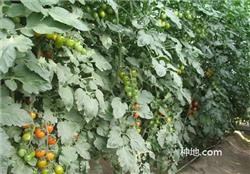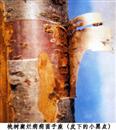How to increase production by planting cherry tomatoes in greenhouse?

How can planting cherry tomatoes in greenhouse increase production? In the annual cultivation of cherry tomato in greenhouse, for the middle and late ripening varieties with strong growth potential and long fruiting period, such as Taiwan Shengnu, Yazu 6 and 139, the leaves can be evenly distributed by using cultivation techniques such as continuous coring and falling vines. Maintain a reasonable lighting position, improve photosynthetic efficiency, make the plant always maintain exuberant growth potential and achieve the effect of increasing yield. First, pick the heart continuously. When the trunk bears 2 spikes, leave 2 leaves at the top to pick the heart, this fruit branch is called the first fruiting branch. The fruit of the first inflorescence began to be harvested, and when the fruit of the second inflorescence began to expand, a strong lateral branch under the top ear was retained to continue to grow instead of the trunk. According to the growth of the plant, 2 ears of fruit grow on the lateral branch and then pick the heart, which is the second fruiting branch. When the fruit of the second fruit-bearing branch begins to be harvested, a strong lateral branch is selected from its upper part as the third fruit-bearing branch, and so on. During the whole growth period, the head was changed 6-7 times, with 6-7 fruiting branches per plant and 12-14 spikes per plant. After the fruit branches are left, all the other side branches should be erased, and the side branches should not be knocked off prematurely. Generally, 2 leaves should be retained when they are more than 20 cm long, so that the side branches can be better used to promote the growth of cherry tomato. Second, timely falling vine 1, falling vine time: before falling vine control watering, in order to reduce the water content in the stem vine and enhance its toughness. The falling vine should be carried out in the afternoon in sunny and warm weather, when the water content of the stem is low, the tissue is soft, and it is easy to operate, so as to avoid and reduce the injury of the stem when falling. When falling off the vine, the old yellow leaves and diseased leaves in the lower part of the stem should be removed and taken to the outside of the shed to be buried or burned. All the fruits in this part should also be harvested to avoid the disease of leaves and fruits on the wet ground and form the disease center. Hang the vine when the first inflorescence opens. After the fruit of the first fruit branch was harvested, the first ear of the second fruit branch expanded rapidly, and when the second ear sat down, the vine fell for the first time. After that, the vine will fall once after each fruit branch has been harvested. 2. The method of falling vine: the method of cross-falling vine between plants is adopted, that is, the plant is removed from the rope, the lower old leaves are knocked off, the plant is gently twisted, coiled, and then the vine is suspended again. The fallen vine should be in the same direction in an orderly manner and gradually coiled around both sides of the ridge. When winding the stem vine, it is necessary to bend the stem vine with the natural curvature of the stem vine, do not bend or bend in the opposite direction, to avoid twisting or breaking the stem vine. Each time the vine falls to maintain a leaf stem vine about 15 cm away from the ridge surface, each plant maintains more than 20 functional leaves, and the plant height is maintained at 0.8 m (south of the shed) to 1.5 m (north of the shed). It should be noted that the top of the stem of the front row can not exceed the back row to avoid shading. Ensure that the leaf distribution is uniform, always in the best position of three-dimensional lighting and the best state of leaf area, and the leaf area coefficient is kept at 3-4. Fall vine 5-6 times during the whole growth period. Third, the management after pruning and falling vines 1. Temperature: within a few days after pruning and falling vines, the temperature in the shed should be properly increased to promote the wound healing of injured vines. The temperature is kept at 20-25 ℃ during the day and 15 ℃ at night. 2. Spraying: in order to prevent the pathogen from invading from the stem vine and leaf wound, according to the common diseases of cherry tomato, after pruning and falling vine, spraying Sukeling, Botrytis cinerea, chlorothalonil, mancozeb and other agents to control leaf mold, gray mold, early blight and late blight. 3. Fertilizer and water management: although falling vine can reduce the fruiting position of the plant, it can not shorten the actual distance between the fruiting position and the root system. In addition, the growing nutrient body, such as insufficient supply of fertilizer and water, will cause problems such as worse and worse fruit quality and smaller and smaller fruit. therefore, sufficient fertilizer and water should be supplied to meet the needs of plant growth. Topdressing with potassium sulfate and other potassium fertilizer, each time topdressing 15-20 kg per mu, while watering. 4. Forking and picking old leaves: after the fruit is picked on the fruiting branch, the lateral branches under the fruiting branch should be knocked off in time to ensure the nutritional supply of the fruiting branch, and all the leaves under the fruiting branch should be removed at the same time. The leaves on the ear can not be removed to ensure the good development of the upper fruit. Forking and picking old leaves should be carried out on a sunny day to facilitate wound healing. When forking, the forked hand only touches the oyster, not the whole dry, in order to avoid the spread of tobacco mosaic virus disease. Picking leaves should be removed as far as possible near the branches, pay attention to do not leave petioles, so as not to produce gray mold. Fourth, pest control. The main diseases are early blight, leaf mold, gray mold and canker. Bordeaux solution can be used for prevention and treatment at the initial stage of the disease, and 70% methyl topiramate 1000-fold solution or 75% chlorothalonil solution can be used for prevention and treatment in the later stage. The main pests are Helicoverpa armigera, cabbage green insects, aphids and so on, which harm leaves and fruits. Tianrun insecticidal No. 1 or Tianrun insecticidal No. 2 has a better control effect on cotton bollworm and cabbage insect, and Sully or insect egg has a good control effect. Aphids can be controlled by imidacloprid or aphid spray. Click to see more virgin fruit planting techniques click to see more fruit planting techniques
- Prev

What about cherry tomatoes growing?
What if I find that the cherry tomatoes planted now are flourishing? Can be controlled by the following methods: control the growth of cherry tomato, the practice has proved that the effect of vine control is very good. Pressure vine can weaken the apical dominance and inhibit the rapid progress of vegetative growth, which can be used to regulate the growth of plants. ...
- Next

How to cure peach rot disease?
How should peach tree rot disease be treated? Peach rot disease overwinters mainly in the form of mycelium and conidia in loquat diseased trunk and other dead bodies. Mycelia usually spread through rain and invade infected tree body through wound. Under normal management, tree load is a key factor affecting disease...
Related
- Moge, come on! The staff of the peasant association in the producing area of cantaloupe were frightened when the crowd gathered.
- Causes and Solutions of low Fruit setting rate of Apple
- Symptoms and control measures of passion fruit virus disease
- Fruit growing lesson: how do apple orchards keep high yields?
- Can you build orchards in the mountains? What are the pros and cons?
- How to manage the coloring period of Crisson grape?
- This paper introduces the processing technology of two kinds of fig products.
- How much is a month for retired teachers in rural areas by 2020?
- How can strawberry planting increase sugar content? We should pay attention to management in many aspects.
- What are the cultivation techniques on how to improve the yield of golden fruit?

